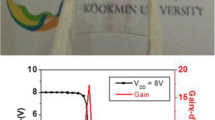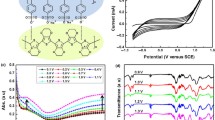Abstract
Encapsulation is indispensable for organic thin-film electronic devices to ensure reliable operation and long-term stability. For thin-film encapsulating organic electronic devices, insulating polymers and inorganic metal oxides thin films are widely used. However, spin-coating of insulating polymers directly on organic electronic devices may destroy or introduce unwanted impurities in the underlying organic active layers. And also, sputtering of inorganic metal oxides may damage the underlying organic semiconductors. Here, we demonstrated that by utilizing vacuum evaporated lithium fluoride (LiF) as protective buffer layer, spin-coated insulating polymer polyvinyl alcohol (PVA), and sputtered inorganic material Er2O3, can be successfully applied for thin film encapsulation of copper phthalocyanine (CuPc)-based organic diodes. By encapsulating with LiF/PVA/LiF trilayer and LiF/Er2O3 bilayer films, the device lifetime improvements of ~10 and 15 times can be achieved. These methods should be applicable for thin-film encapsulation of all kinds of organic electronic devices. Moisture-induced hole trapping, and Al top electrode oxidation are suggest to be the origins of current decay for the LiF/PVA/LiF trilayer and LiF/Er2O3 bilayer films encapsulated devices, respectively.





Similar content being viewed by others
References
F.C. Krebs, J. Fyenbo, D.M. Tanenbaum, S.A. Gevorgyan, R. Andriessen, B.V. Remoortere, Y. Galagan, M. Jrgensen, The OE-A OPV demonstrator anno domini 2011. Energy Environ. Sci 4, 4116–4123 (2011)
M.T. Lloyd, C.H. Peters, A. Garcia, I.V. Kauvar, J.J. Berry, M.O. Reese, M.D. McGehee, D.S. Ginley, D.C. Olson, Influence of the hole-transport layer on the initial behavior and lifetime of inverted organic photovoltaics. Solar Energy Mater. Solar Cells 95, 1382–1388 (2011)
J. Meyer, D. Schneidenbach, T. Winkler, S. Hamwi, T. Weimann, P. Hinze, S. Ammermann, H.H. Johannes, T. Riedl, W. Kowalsky. Reliable thin film encapsulation for organic light emitting diodes grown by low-temperature atomic layer deposition. Appl. Phys. Lett. 94, 233305 (2009)
J. S. Lewis, M. S. Weaver, Thin-film permeation-barrier technology for flexible organic light-emitting devices. IEEE J. Sel. Top. Quant. 10, 45–57 (2004)
P.E. Burrows, V. Bulovic, S.R. Forrest, L.S. Sapochak, D.M. McCarty, M.E. Thompson. Reliability and degradation of organic light emitting devices. Appl. Phys. Lett. 65, 2922 (1994)
F. C. Krebs, Roll-to-roll fabrication of monolithic large-area polymer solar cells free from indium-tin-oxide. Solar Energy Mater. Solar Cells 93, 1636–1641 (2009)
S. Seethamraju, P.C. Ramamurthy, G. Madras, Organic passivation layer on flexible Surlyn substrate for encapsulating organic photovoltaics. Appl. Phys. Lett. 105, 104102 (2014)
N. Kim, W. J. Potscavage, A. Sundaramoothi, C. Henderson, B. Kippelen, S. Graham, A correlation study between barrier film performance and shelf lifetime of encapsulated organic solar cells. Solar Energy Mater. Solar Cells 101, 140–146 (2012)
H. Klumbies, P. Schmidt, M. Hänel, A. Singh, U. Schroeder, C. Richter, T. Mikolajick, C. Hoßach, M. Albert, J.W. Bartha, K. Leo, L.M. Meskamp, Thickness dependent barrier performance of permeation barriers made from atomic layer deposited alumina for organic devices. Org. Electron 17, 138–143 (2015)
M. D. Clark, M. L. Jespersen, R. J. Patel and B. J. Leever, Ultra-thin alumina layer encapsulation of bulk heterojunction organic photovoltaics for enhanced device lifetime. Org. Electron. 15(1), 1–8 (2014)
P.F. Carcia, R.S. McLean, M.H. Reilly, Permeation measurements and modeling of highly defective Al2O3 thin films grown by atomic layer deposition on polymers. Appl. Phys. Lett. 97, 221901 (2010)
Y.C. Han, E. Kim, W. Kim, H.G. Im, B.S. Bae, K.C. Choi, A flexible moisture barrier comprised of a SiO2-embedded organic-inorganic hybrid nanocomposite and Al2O3 for thin-film encapsulation of OLEDs. Org. Electron 14(6), 1435–1440 (2013)
K. Li, H. Fan, C. Huang, X. Hong, X. Fang, H. Li, X. Liu, C. Li, Z. Huang, H. Zhen, Thin-film encapsulation of inverted indium-tin-oxide-free polymer solar cells by atomic layer deposition with improvement on stability and efficiency. Appl. Phys. Lett. 101(23), 233902 (2012)
B. Singh, J. Bouchet, G. Rochat, Y. Leterrier, J.-A. E. Månson, P. Fayet, Ultra-thin hybrid organic/inorganic gas barrier coatings on polymers. Surf. Coat. Tech. 201, 7107 (2007)
J. Meyer, H. Schmidt, W. Kowalsky, T. Riedl, A. Kahn, The origin of low water vapor transmission rates through Al2O3/ZrO2 nanolaminate gas-diffusion barriers grown by atomic layer deposition. Appl. Phys. Lett. 96, 243308 (2010)
S.W. Seo, E. Jung, H. Chae, S.M. Cho, Optimization of Al2O3/ZrO2 nanolaminate structure for thin-film encapsulation of OLEDs. Org. Electron 13(11), 2436–2441 (2012)
C.Y. Chang, C.T. Chou, Y.J. Lee, M.J. Chen, F.Y. Tsai, Thin-film encapsulation of polymer-based bulk-heterojunction photovoltaic cells by atomic layer deposition. Org. Electron 10, 1300 (2009)
E. Kim, Y. Han, W. Kim, K.C. Choi, H.G. Im, B.S. Bae, Thin-film encapsulation for organic light emitting diodes using a multi-barrier composed of MgO prepared by atomic layer deposition and hybrid materials. Org. Electron 14(7), 1737–1743 (2013)
L.H. Kim, K. Kim, S. Park, Y.J. Jeong, H. Kim, D.S. Chung, S.H. Kim, C.E. Park, Al2O3/TiO2 nanolaminate thin film encapsulation for organic thin film transistors via plasma-enhanced atomic layer deposition. ACS Appl. Mater. Interfaces 6(9), 6731–6738 (2014)
B.J. Kim, D.H. Kim, S.Y. Kang, S.D. Ahn, S.G. Im, A thin film encapsulation layer fabricated via initiated chemical vapor deposition and atomic layer deposition. J. Appl. Polym. Sci 131, 40974 (2014)
S.W. Seo, H. Chae, S.J. Seo, H.K. Chung, S.M. Cho, Extremely bendable thin-film encapsulation of organic light-emitting diodes. Appl. Phys. Lett. 102(16), 161908 (2013)
N. Kim, W.J. Potscavage, B. Domercq, B. Kippelen, S. Graham, A hybrid encapsulation method for organic electronics. Appl. Phys. Lett. 94, 163308 (2009)
J. Meyer, P. Görrn, F. Bertram, S. Hamwi, T. Winkler, H.-H. Johannes, T. Weimann, P. Hinze, T. Riedl, W. Kowalsky, Al2O3/ZrO2 nanolaminates as ultrahigh gas-diffusion barriers—a strategy for reliable encapsulation of organic electronics. Adv. Mater 21, 1845–1849 (2009)
H. Fujimoto, W.J. Potscavage, T. Edura, C. Adachi, Analysis of electron traps formed in organic films with a sputtered cathode. Org. Electron 15, 2783–2791 (2014)
M.P. Gaj, F.-H. C, Y. Zhang, S.R. Marder, B. Kippelen, Highly efficient organic light-emitting diodes from thermally activated delayed fluorescence using a sulfone-carbazole host material. Org. Electron 16, 109–112 (2015)
G. Fu, T. Wang, J. Cai, J. Shi, Z. Luo, G. Li, X. Li, Z. Zhang, S. Yang, Formation of charge transfer complexes significantly improves the electron transfer process of polymer solar cells. Org. Electron 18, 70–76 (2015)
X. Luo, B. Yao, W. Lv, Y. Li, Z. Wu, L. Sun, Z. Wen, Y. Peng, Operational dynamics and architecture dependence of double-gate OFETs with balanced top and bottom channel characteristics. J. Mater. Chem 3, 7336–7344 (2015)
X. Qian, T. Wang, D. Yan, High mobility organic thin-film transistors based on p-p heterojunction buffer layer. Appl. Phys. Lett. 103(17), 173512 (2013)
L. Sun, J. Zhang, F. Zhao, X. Luo, W. Lv, Y. Li, Q. Ren, Z. Wen, Y. Peng, X. Liu, Ultrahigh near infrared photo responsive organic field-effect transistors with lead phthalocyanine /C60 heterojunction on poly (vinyl alcohol) gate dielectric. Nanotechnology 26, 185501–185510 (2015)
W. Wang, D. Ma, S. Pan, Y. Yang, Hysteresis mechanism in low-voltage and high mobility pentacene thin-film transistors with polyvinyl alcohol dielectric. Appl. Phys. Lett. 101(3), 033303 (2012)
Y. Sun, Y. Liu, Y. Wang, C. Di, W. Wu, G. Yu, Polymer gate dielectrics with self-assembled monolayers for high-mobility organic thin-film transistors based on copper phthalocyanine. Appl. Phys. A. 95, 777–780 (2009)
M. Gedda, N. V. V. Subbarao, Sk. Md. Obaidulla, and D. K. Goswami, High carrier mobility of CoPc wires based field-effect transistors using bilayer gate dielectric, AIP Adv. 3, 112123 (2013)
J. H. Seo, J. Kwon, S. Shin, K.-S. Suh and B.-K. Ju, Organic thin film transistors with polyvinyl alcohol treated dielectric surface. Semicond. Sci. Tech. 22, 1039–1043 (2007)
S. Takebayashi, S. Abe, K. Saiki, K. Ueno, Origin of the ambipolar operation of a pentacene field-effect transistor fabricated on a poly (vinyl alcohol)-coated Ta2O5 gate dielectric with Au source/drain electrodes. Appl. Phys. Lett. 94, 083305 (2009)
S. Mahendia, A. Kumar Tomar, P.K. Goyal, S. Kumar, Tuning of refractive index of poly (vinyl alcohol): Effect of embedding Cu and Ag nanoparticles. Jpn. J. Appl. Phys 113(7), 073103 (2013)
S. Mitra, S. Banerjee, D. Chakravorty, Tunneling conduction in graphene/(poly)vinyl alcohol composite. Jpn. J. Appl. Phys 113(15), 154314 (2013)
Y.Y. Zhu, Fowler-Nordheim hole tunneling in metal-Er2O3-silicon structures. Appl. Phys. Lett. 91, 122914 (2007)
M. Losurdo, M.M. Giangregorio, G. Bruno, Er2O3 as a high-K dielectric candidate. Appl. Phys. Lett. 91, 091914 (2007)
R. Xu, Q. Tao, Y. Yang, C.G. Takoudis, Atomic layer deposition and characterization of stoichiometric erbium oxide thin dielectrics on Si (100) using (CpMe)3Er precursor and ozone. Appl. Surf. Sci. 258, 8514–8520 (2012)
F. De Angelis, S. Cipolloni, L. Mariucci, G. Fortunato, Aging effects in pentacene thin-film transistors: Analysis of the density of states modification. Appl. Phys. Lett. 88, 193508 (2006)
J.E. Northrup, M.L. Chabinyc, Gap states in organic semiconductors: hydrogen-and oxygen-induced states in pentacene. Phys. Rev. B 68, 041202 (2003)
Y. Q. Peng, F. J. Zhang, X. Zhang, D. S. Zheng, Numerical analysis on the current conduction in single layer organic light-emitting devices. Appl. Phys. A: Mater. Sci. Process. 78, 369–373 (2004)
Acknowledgements
This work was supported by the National Program on Key Research Project Grant No. 2016YFF0203605.
Author information
Authors and Affiliations
Corresponding author
Rights and permissions
About this article
Cite this article
Peng, Y., Ding, S., Wen, Z. et al. Thin-film encapsulation of organic electronic devices based on vacuum evaporated lithium fluoride as protective buffer layer. Appl. Phys. A 123, 178 (2017). https://doi.org/10.1007/s00339-017-0818-4
Received:
Accepted:
Published:
DOI: https://doi.org/10.1007/s00339-017-0818-4




